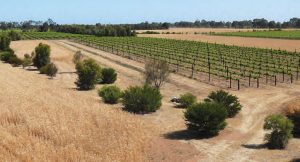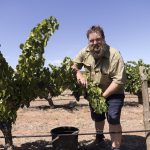By Dennis Elliott, Karanto Vineyards Pty Ltd, Langhorne Creek, South Australia
First published in the July/August 2011 issue of the Wine & Viticulture Journal


Our small half-hectare block of Aglianico was planted in September 2004 and the first batch of wine was made from the 2007 vintage. The 2007 and 2008 vintages were made in conjunction with consultant winemaker Briony Hoare, of Hoare Consulting and Beach Road Wines, and marketed under our Karanto Vineyard label. In 2009, the crop suffered serious bird damage just prior to harvest and the resulting wine proved to be unsound and was discarded. Since 2010, Briony has taken over full responsibility for the winemaking and will market it under her Beach Road Wines label. Karanto will continue to manage the vineyard.
When we decided to experiment with Aglianico, it was not our intention to try and replicate either the way the variety was managed or wines produced in Campania, but rather to see how it would develop at Langhorne Creek managed in a similar manner to our Shiraz and Cabernet. So far, the wines have shown some of the savoury and tannic characteristics of the Campanian Aglianicos that we have tried but have a touch more fruit character. It is a wine best consumed with food. The 2007 vintage, which is now almost sold out, has had some wine show success, winning a gold medal and trophy for ‘best other red’ at the 2009 Small Vignerons Wine Awards, gold at the Cowra Wine Show in 2009, ‘Best Alternative Variety’ at the 2009 Langhorne Creek Wine Showcase and numerous silvers and bronzes.
Our Aglianico was sourced from Chalmers Nursery, at Euston, in New South Wales, and we have two clones, Taurasi VCR 23 and MAT 2, grafted to Schwarzmann and Teleki 5C rootstocks. Soils consist of 300-500mm of red brown sandy loam over orange brown sandy clay extending to beyond two metres. The block is flat, rows are oriented north-south, while row and vine spacing is 3m by 1.75m. The vines are trained to a single cordon at 1m with a catch wire at 1.5m, and are pruned to seven twobud spurs per metre. Shoot thinning to remove non-count shoots is carried out in October/November and bunch thinning is carried out after veraison to maintain some bunch separation and a cropping level of around 6-8 tonnes per hectare.
Langhorne Creek has an annual rainfall of 375mm, most of which falls between May and September. Supplementary irrigation is supplied via one 4L/hour dripper per vine. As with our Cabernet and Shiraz, regulated deficit irrigatoin is practised with minimal or no irrigation between fruitset and veraison. Depending on seasonal conditions, between 100-160mm (1-1.6ML/ha) is applied, some of this as a leaching irrigation during late winter.
Over the relatively short time we have been growing Aglianico, the seasonal conditions have not been what might be regarded as ‘normal’. There have been several years of drought, including a period in March in 2008 with 14 days of over 40°C temperatures, a reduction in the quality of irrigation water available from Lake Alexandrina as a result of the problems in the Murray Darling system (increase in salinity from 300ppm to 2000ppm) necessitating the use of bore water (1000-1200ppm) during 2008-09 and 2009-10 and, finally, an excessively wet growing season in 2010-11.
It is, therefore, probably a bit premature to be making any assessment of how Aglianico will perform in the long term but, from our experience, the following observations can be made:
- The vines grew quite vigorously during the first two or three years when vine structure was being established.
- During the hot and dry conditions from 2007 to 2010, when water quality was also an issue, vine vigour was low to medium. How much of this was due to the rootstocks used and how much to the Aglianico is unclear. There were, however, noticeable differences between vines on Teleki 5C and those on Schwarzmann. Teleki 5C was not a good choice of rootstock for the conditions experienced in those seasons.
- We have not noticed any significant differences between the two clones Taurasi VCR 23 and MAT 2.
- Aglianico is a variety with a long growing season. At Langhorne Creek, budburst occurs in late September, flowering in late November, veraison in late January or early February and harvest mid to late April. Compared with our Shiraz and Cabernet, budburst of Aglianico is similar but it is harvested three to four weeks later than Shiraz and two weeks later than Cabernet.
- Aglianico is quite fruitful, including those canes arising from basal buds, and once vine structure is established could be quite heavily pruned (and, in fact, this is the case in vineyards we have visited in Campania).
- Bunches can be quite large, up to 300g and averaging 175g. Berry size is medium to large and berries are thick skinned.
- Crop level has been consistent at around 7-7.5t/ha until the 2010-11 harvest when the wet conditions increased bunch and berry size and produced a crop of 9t/ha.
- Crops have ripened consistently even with the low vigour and smaller canopies of the dry years from 2007 to 2010. Harvesting has been based on flavour development but has generally occurred at around 12.8-13.4Baume.
- Aglianico machine harvests well.
- To date, the only disease problem we have had has been some botrytis infection during the wet 2011 vintage.
AGLIANICO

By Peter Dry, Emeritus Fellow, The Australian Wine Research Institute
Background
There are at least 40 synonyms of Aglianico (ah-lee-AHN-eeko)—the main ones are Ellanico, Ellenico, Glianica and Glianico. Aglianico comes from southern Italy, particularly Campania (Taurasi and Taburno) and Basilicata (Vulture), where it is one of the most widely planted varieties. The long list of synonyms reflects the large number of biotypes and toponyms—DNA profiling has confirmed that the biotypes are one variety, although there may be variability in morphological characteristics.
Aglianico has a good reputation in southern Italy and is known as “the Barolo of the south” because it can produce big wines with great longevity. In Campania, it makes the DOCG wine, Aglianico del Taurasi, and in Basilicata, the DOC wine, Aglianico del Vulture. Globally there were 9963 ha in 2010 (up 8% from 2000), close to 100% in Italy and mainly in Basilicata and Campania. Planting is increasing outside the traditional areas. In Australia there are currently at least 20 wine producers, more than half in warm to hot climatic regions in SA (10 ha).
Viticulture
In Australia, Aglianico bursts about the same time as Cabernet Sauvignon but ripens about 2 to 3 weeks later. Bunches are well-filled and yield is medium to high. In Italy, Aglianico typically grows on deep soils of volcanic origin, with some clay content, but is said to be adapted to a range of soil types. It is said to perform best at 400-900 m—but we assume that this is not because it prefers high elevations but rather that the high elevation sites have the most suitable climate for the desired wine specifications. It requires good bunch exposure and ripening temperatures.
Aglianico performs well on a variety of rootstocks. The main rootstocks used in Campania are 1103P, SO4, 5BB, and to a lesser extent 420 A. At Langhorne Creek, in the Karanto vineyard, it is grown on Schwarzmann and Teleki 5C. There is significant clonal variation with Taburno biotypes being vigorous with large bunches and berries, Taurasi with moderate vigour and smaller bunches and Vulture similar to the Taurasi. Clones of both Vulture and Taurasi biotypes are available in Australia.
In high quality Taurasi vineyards, it is trained to a vertical trellis, pruned to 10 – 15 buds per vine with row x vine spacing of 2.0 x 1.2 m. In Taburno, a large overhead trellis (‘tendone’) with 100 buds per vine and 3.0 x 3.0 m spacing is utilised. At Langhorne Creek, Aglianico is spur pruned and trained onto a trellis with single fruiting and foliage wires with a row x vine spacing of 3.0 x 1.8 m.
Aglianico has been successfully machine harvested in Australia. It has tolerance of powdery mildew but is susceptible to Botrytis. At Langhorne Creek, it is reported to have handled hot and dry conditions well, although suffering slight sunburn. Aglianico ripens late and achieves a good sugar level while retaining good acidity.
Wine
Aglianico wines have an intense ruby-red or cherry colour, complex aroma, powerful structure, drying tannins—that can sometimes be bitter—and they soften and develop with ageing. They have intense and complex aromas of spice, blackberries, cherries, plum, leather, cigar box and tea leaf. The following tasting notes on the 2007 Karanto Aglianico are derived from comments made at the 2010 AWITC Workshop on Emerging Mediterranean varieties in Australia: “pine tree, resinous, plush, tannins, dryness and savoury, herbaceous, berry, cherry, fresh fruit, cigar box, complex”.




















